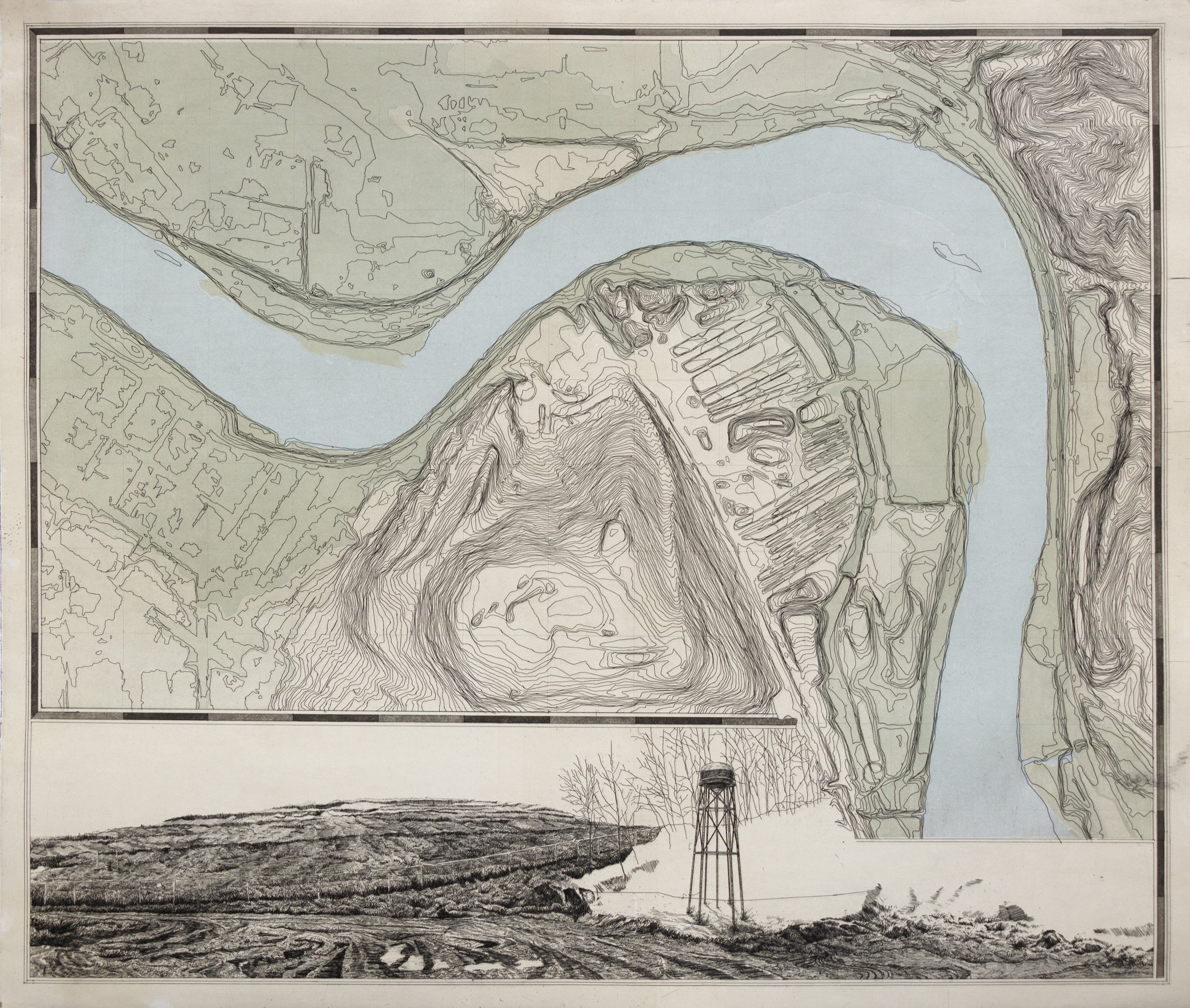
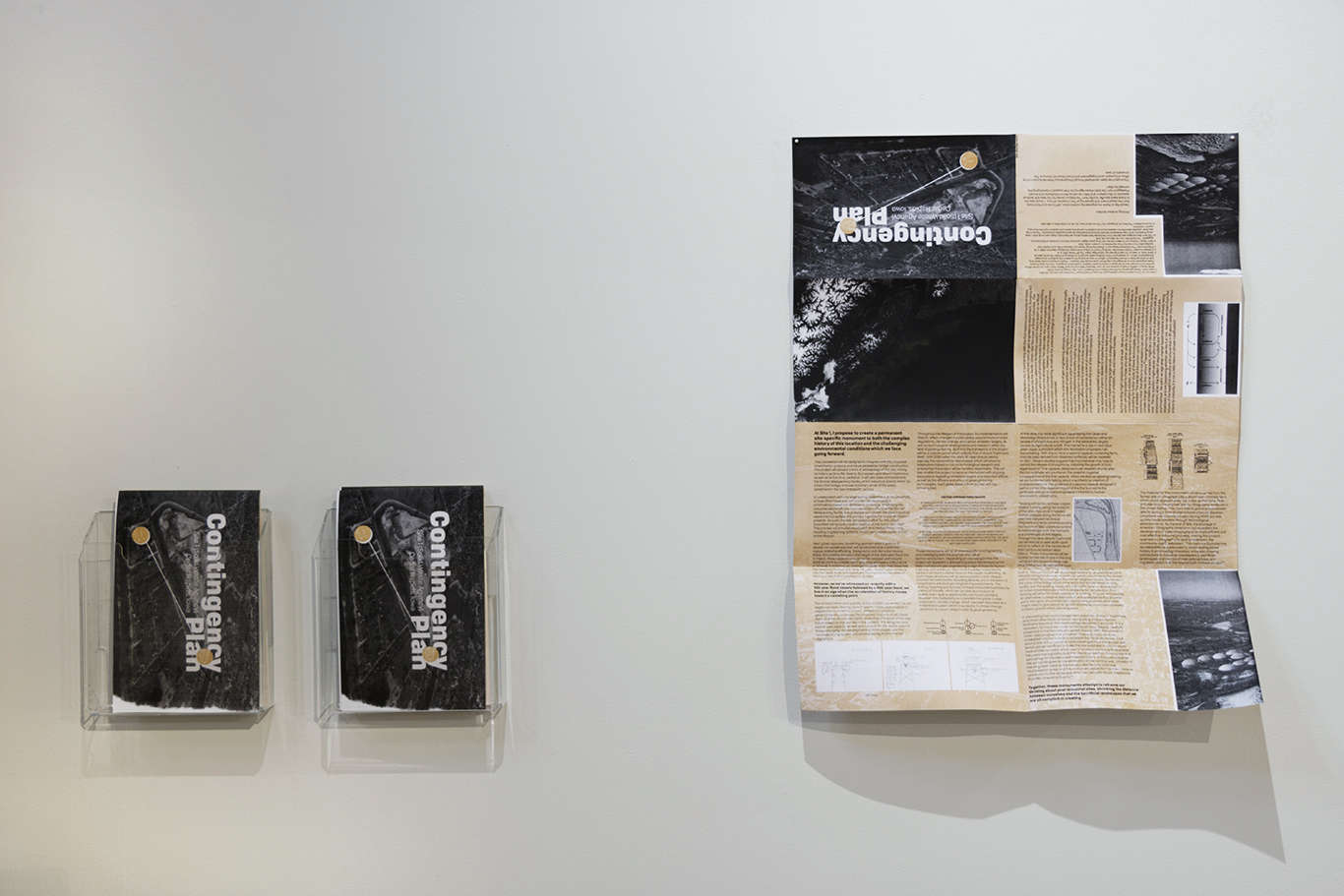
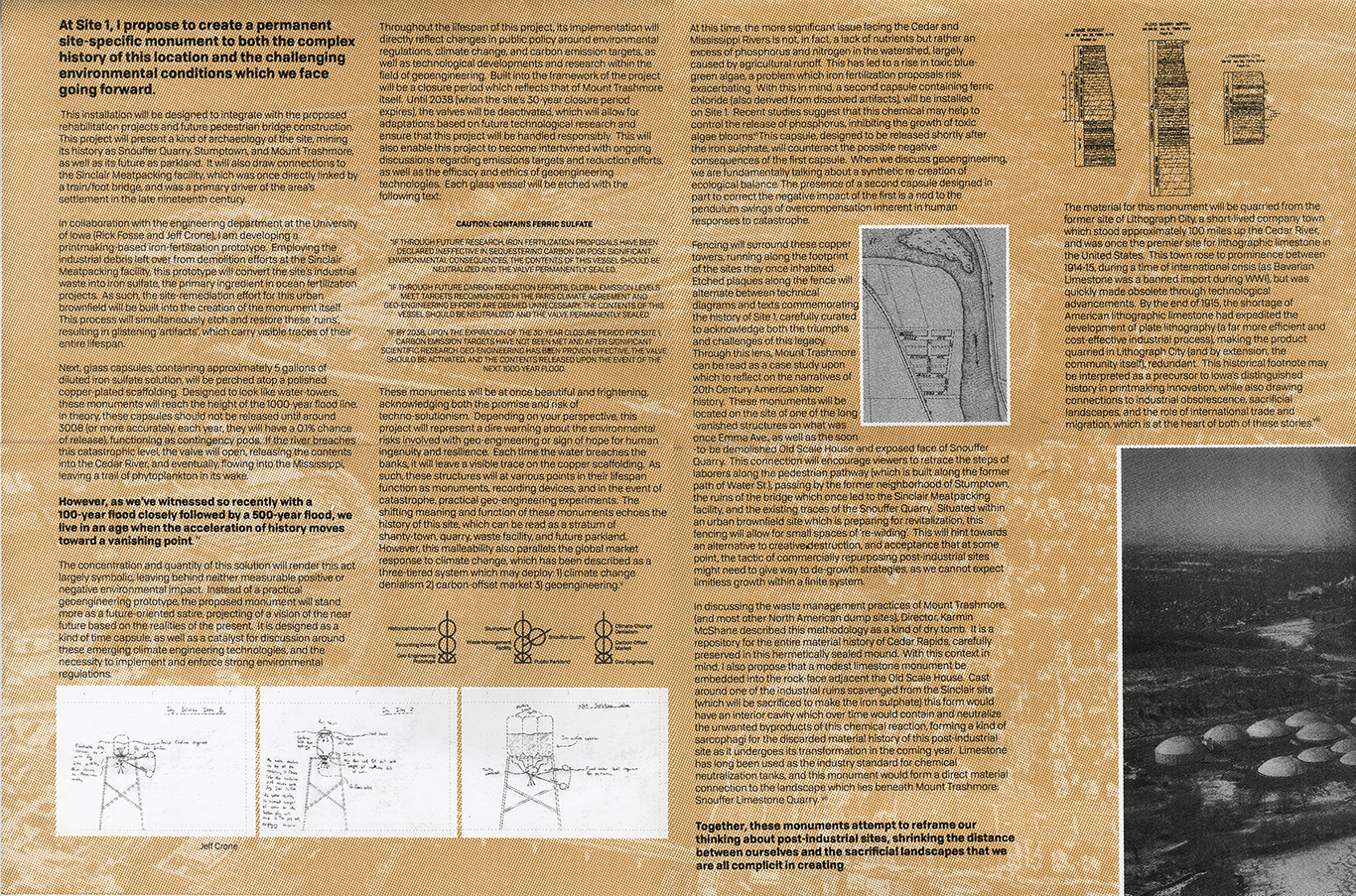
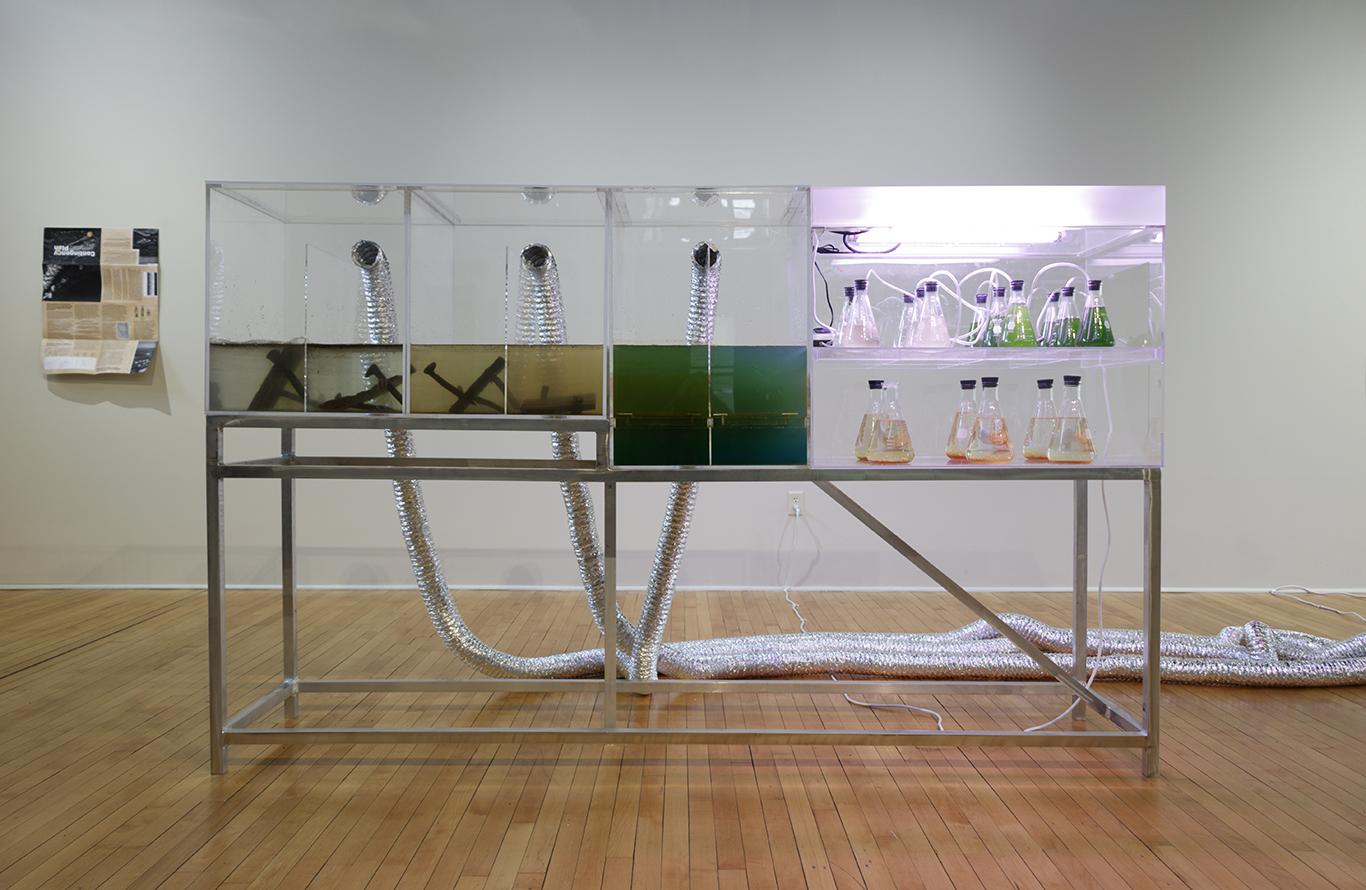
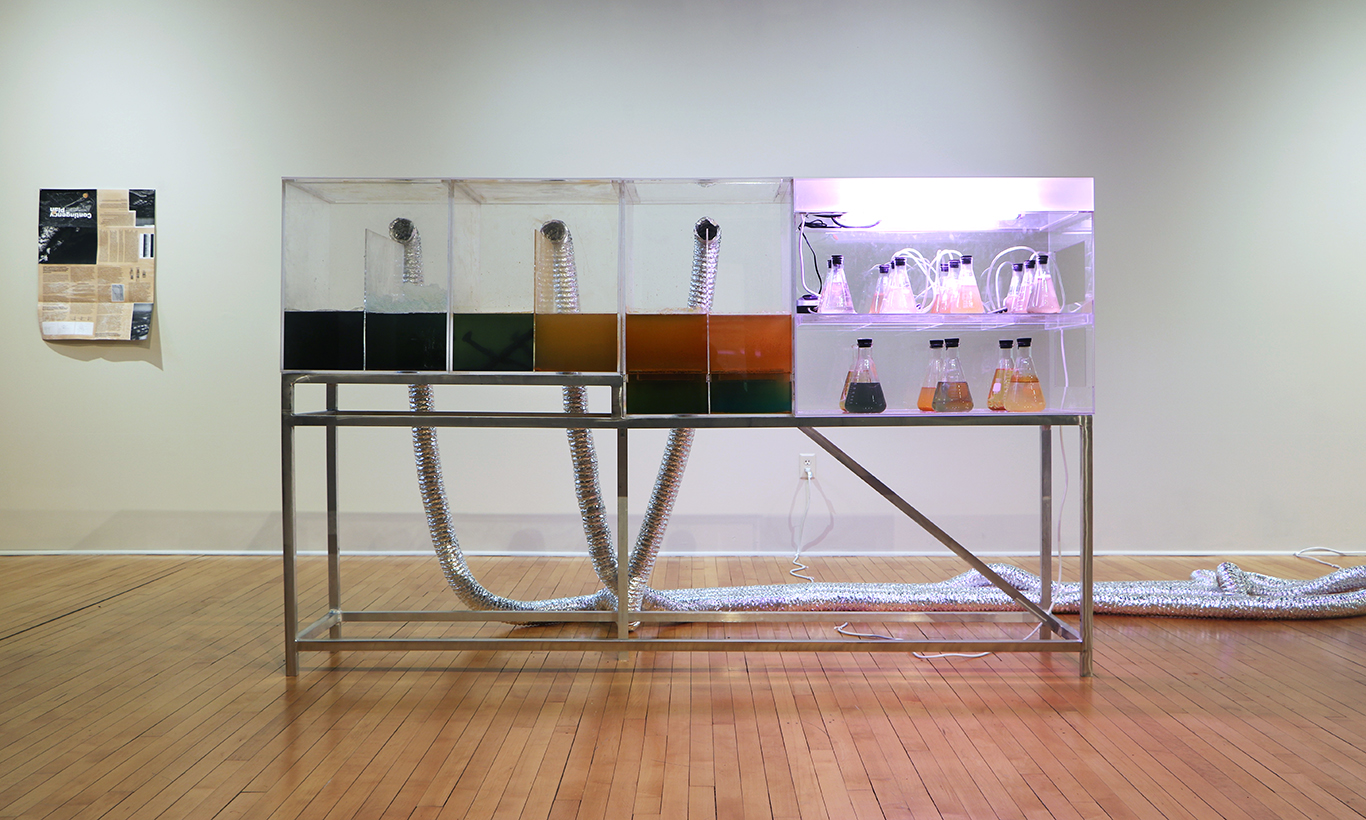
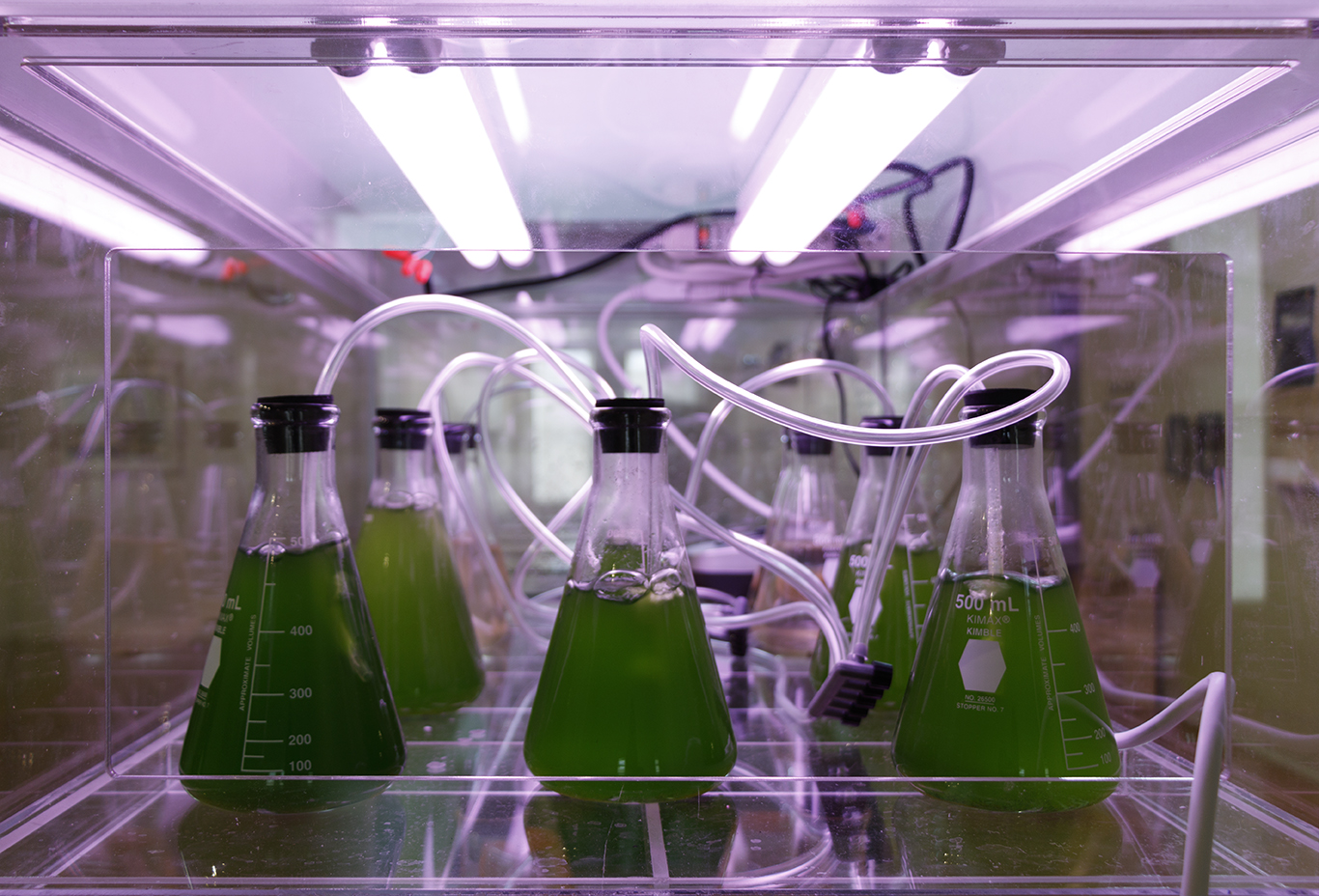
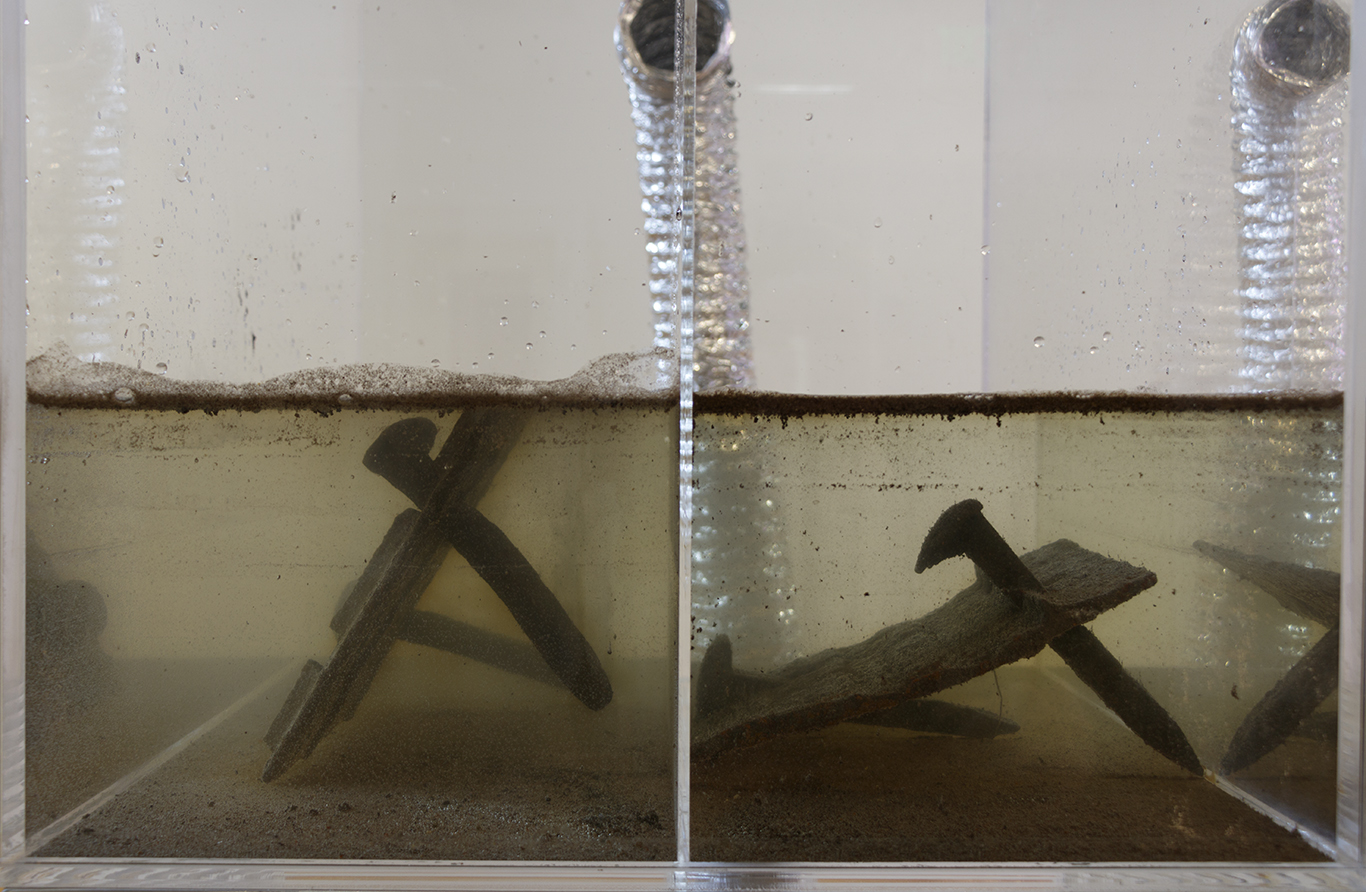

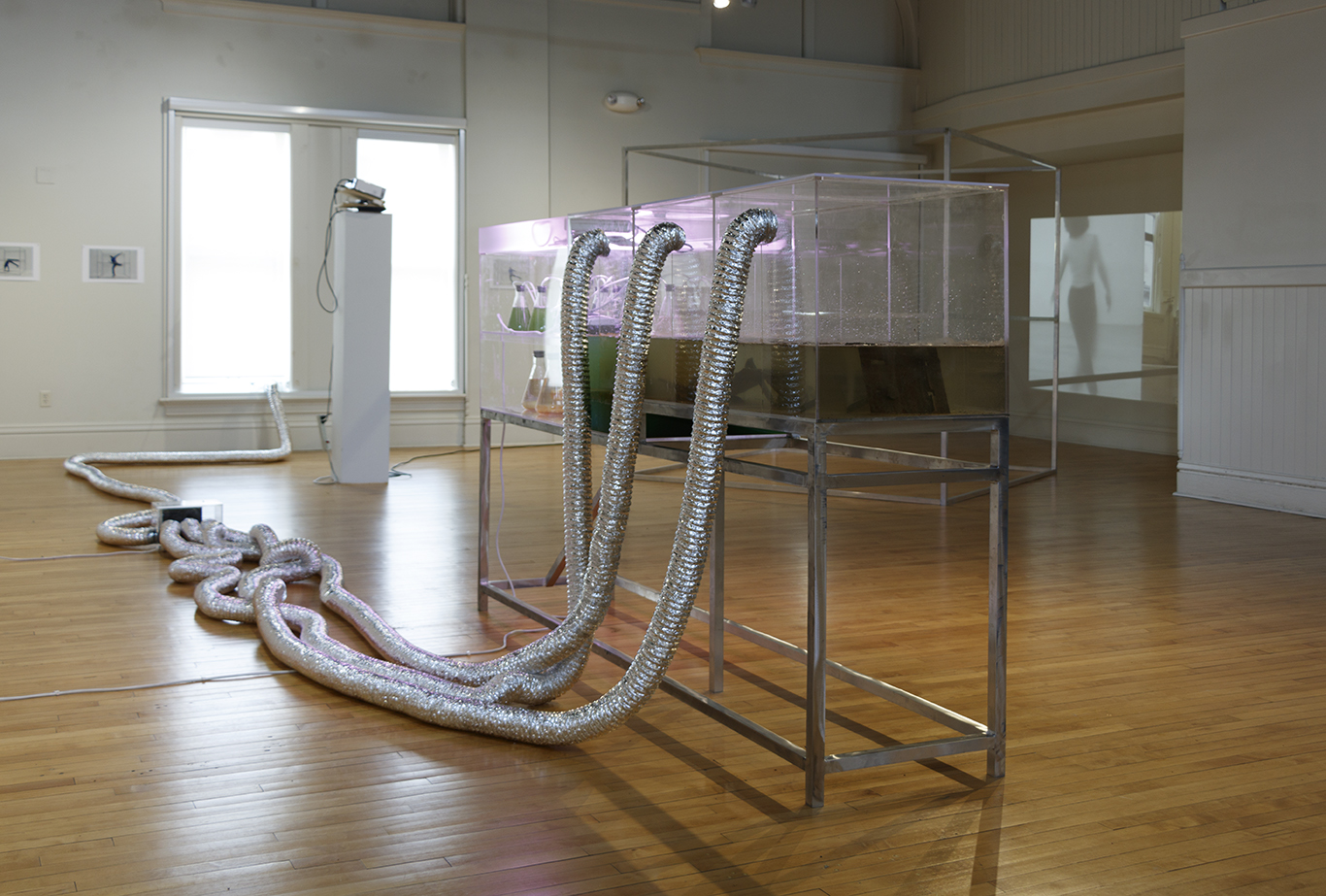
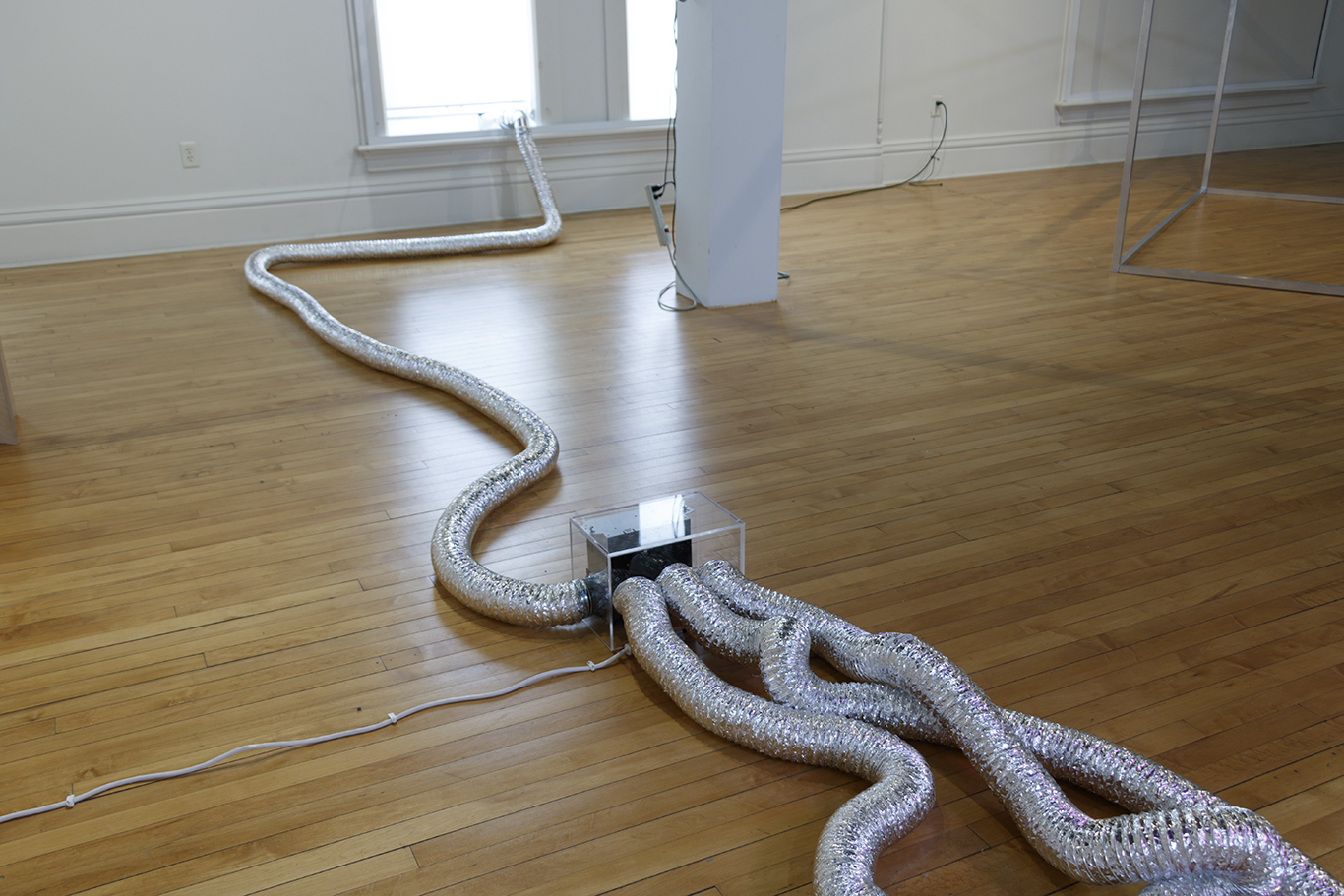
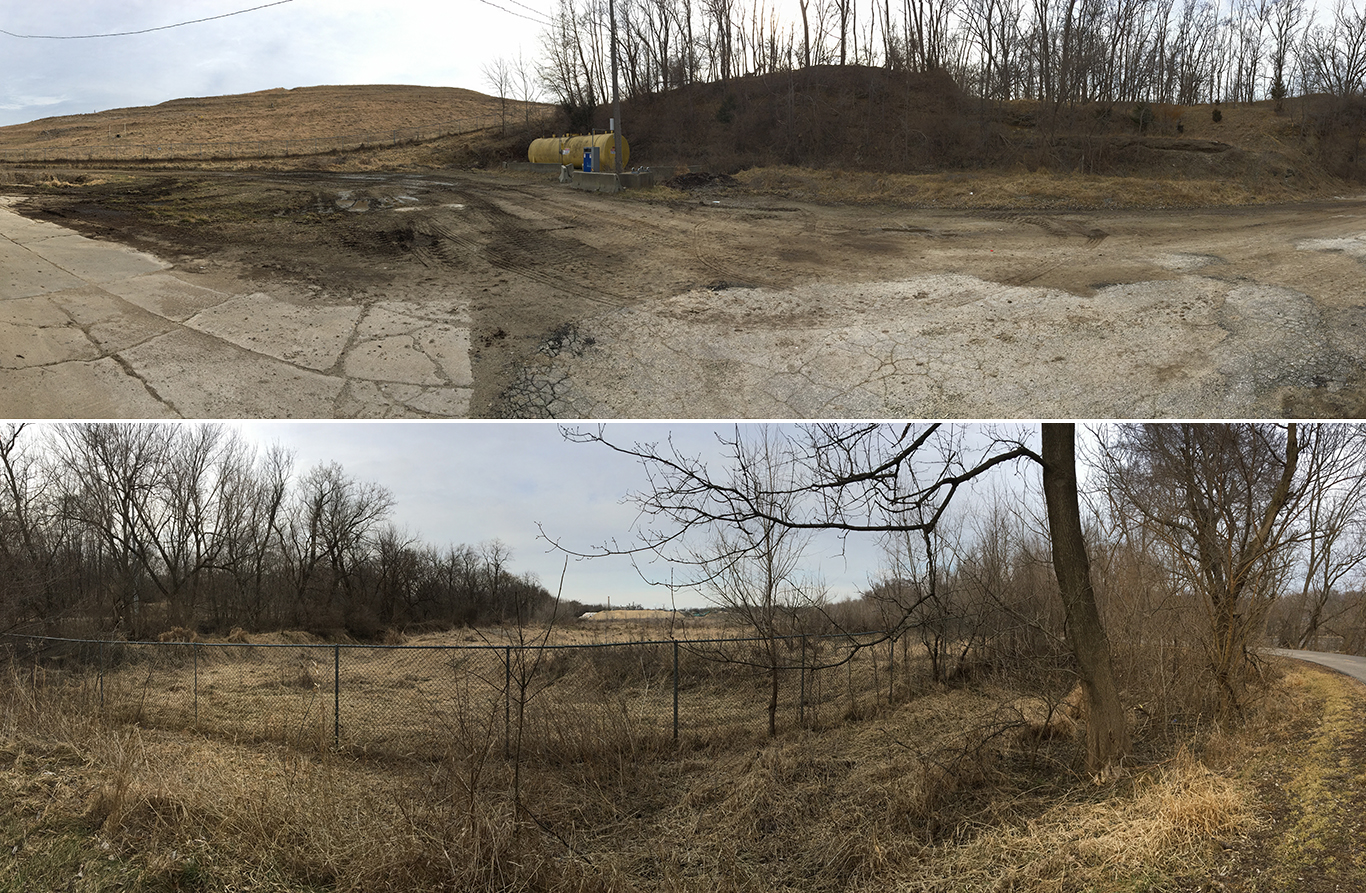

Contingency Plan, Cedar Rapids, IA (2017)
Contingency Plan proposes a public monument for Site 1 (Mount Trashmore) in Cedar Rapids, Iowa. This installation has been designed to integrate with the site's proposed rehabilitation projects, while shedding light on both the complex history of this location and the prospect of geo-engineering on the horizon. This project mines the site’s history as Snouffer Quarry, Stumptown, and Mount Trashmore.
In consultation with the engineering department at the University of Iowa, I have developed a printmaking-based iron-fertilization prototype, which employs the industrial debris left over from demolition efforts at the nearby Sinclair Meatpacking facility. This prototype will convert the site’s industrial waste into iron sulfate, the primary ingredient in ocean fertilization geo-engineering projects. As such, the site-remediation effort for this urban brownfield will be built into the creation of the monument itself.
The iron sulfate solution will be stored in etched glass capsules, perched at the 1000-year flood level, atop copper-plated scaffolding. In theory, these capsules should not be released until around 3008 (or more accurately, each year, they will have a 0.1% chance of release). If the river breaches this catastrophic level, a valve will open, releasing the contents into the Cedar River, leaving a trail of phytoplankton in its wake. However, as we’ve witnessed so recently with a 100-year flood closely followed by a 500-year flood, we live in an age when the acceleration of history moves toward a vanishing point.
Contingency Plan was developed with the support of The Office of Outreach and Engagement and Grant Wood Art Colony, University of Iowa.
Image: Contingency Plan, etching on paper (ferric chloride and iron sulfate ink), 24"x28", 2017.

Contingency Plan, silkscreen brochure (with ferric chloride ink), 30"x24" (8-fold/two-sided), 2017.
Printing: Andrew Mullally
Engineering Renderings: Jeff Crone

Contingency Plan, artifacts (Sinclair Meatpacking Plant), plexiglas, aluminum, glass, grow-lights, sulfuric acid, hydrochloric acid, copper sulphate, water samples (Cedar River), ventilation unit, 58"x95"x22", 2017.

Proposed Locations: Site 1 (Solid Waste Agency), Cedar Rapids, IA
Full Text:
Background:
In July of 2012, Planktos Inc, in partnership with the First Nations community of Haida Gwaii, conducted an unsanctioned open air geo-engineering experiment, dumping 100 tons of iron sulfate into the Pacific Ocean, near the coast of British Columbia. This controversial technique, called iron fertilization, could in theory spawn an artificial plankton bloom which would simultaneously boost the local fishery while absorbing carbon dioxide from the atmosphere. Two years later, the region experienced its largest recorded sockeye run. However, concerns about this project’s effectiveness towards carbon sequestering, as well as the potential ecological ramifications remained unresolved.
At its core, the science of geo-engineering attempts to mimic, accelerate, or amplify natural processes of carbon reduction using highly invasive means. These are theoretical interventions which account for the imminent ecological threat that we face, and the unlikelihood of society making the necessary adjustments in time. These strategies form a dystopian contingency plan, which employed alongside mitigation efforts, strive to preserve a close approximation of our present ecosystem. Geo-engineering stands as a kind of messianic figure for the planet. A theory that proposes to wash away the sins of the Anthropocene.
Many of those opposed to geo-engineering argue that the lure of techno-solutionism may reduce the urgency needed to implement drastic carbon reduction measures. At this point, even prominent researchers in the field acknowledge the inherent risks involved in implementing large-scale, strategic chemical spills. Our collective future is in the hands of untested, risky, and invasive theories.
But the writing might already be on the wall. We are in an era which demands urgent action, yet are guided by those who either prefer to ignore the problem, are unable to conceptualize a solution, or are simply hesitant to make the necessary sacrifices. In advocating for further study of these technologies, geo-engineering researcher David Keith stresses “The inertia of the carbon cycle, combined with that of the world’s economy mean that efforts to cut emissions can only moderate (but not reverse) climate change over this century.” Geoengineering is not a substitute for reducing carbon emissions, but at some point, might be a necessary measure to buy us some time. The key question might center on who has the right to experiment with the environment, when the burden of responsibility and the burden of impact are asymmetrical. We are in an age when market-based solutions are already being developed, and are happening whether we like it or not. How can we learn from the failures of the fossil fuel industry, and ensure that in 30 years, when this new market enters its maturity, it is not a Wild-West of climate modification?
Proposal:
At Site 1, I propose to create a permanent site-specific monument to both the complex history of this location and the challenging environmental conditions which we face going forward. This installation will be designed to integrate with the proposed rehabilitation projects and future pedestrian bridge construction. This project will present a kind of archaeology of the site, mining its history as Snouffer Quarry, Stumptown, and Mount Trashmore, as well as its future as parkland. It will also draw connections to the Sinclair Meatpacking facility, which was once directly linked by a train/foot bridge, and was a primary driver of the area’s settlement in the late nineteenth century.
In collaboration with the engineering department at the University of Iowa (Rick Fosse and Jeff Crone), I am developing a printmaking-based iron-fertilization prototype. Employing the industrial debris left over from demolition efforts at the Sinclair Meatpacking facility, this prototype will convert the site’s industrial waste into iron sulfate, the primary ingredient in ocean fertilization projects. As such, the site-remediation effort for this urban brownfield will be built into the creation of the monument itself. This process will simultaneously etch and restore these ‘ruins’, resulting in glistening ‘artifacts’, which carry visible traces of their entire lifespan.
Next, glass capsules, containing approximately 5 gallons of diluted iron sulfate solution, will be perched atop a polished copper-plated scaffolding. Designed to look like water-towers, these monuments will reach the height of the 1000-year flood line. In theory, these capsules should not be released until around 3008 (or more accurately, each year, they will have a 0.1% chance of release), functioning as contingency pods. If the river breaches this catastrophic level, the valve will open, releasing the contents into the Cedar River, and eventually, flowing into the Mississippi, leaving a trail of phytoplankton in its wake. However, as we’ve witnessed so recently with a 100-year flood closely followed by a 500-year flood, we live in an age when the acceleration of history moves toward a vanishing point.
The concentration and quantity of this solution will render this act largely symbolic, leaving behind neither measurable positive or negative environmental impact. Instead of a practical geoengineering prototype, the proposed monument will stand more as a future-oriented satire, projecting of a vision of the near future based on the realities of the present. It is designed as a kind of time capsule, as well as a catalyst for discussion around these emerging climate engineering technologies, and the necessity to implement and enforce strong environmental regulations.
Throughout the lifespan of this project, its implementation will directly reflect changes in public policy around environmental regulations, climate change, and carbon emission targets, as well as technological developments and research within the field of geoengineering. Built into the framework of the project will be a closure period which reflects that of Mount Trashmore itself. Until 2038 (when the site’s 30-year closure period expires), the valves will be deactivated, which will allow for adaptations based on future technological research and ensure that this project will be handled responsibly. This will also enable this project to become intertwined with ongoing discussions regarding emissions targets and reduction efforts, as well as the efficacy and ethics of geoengineering technologies. Each glass vessel will be etched with the following text:
CAUTION: CONTAINS FERRIC SULFATE
*If through future scientific research, iron fertilization proposals have been declared ineffective in sequestering carbon or pose significant environmental consequences, the contents of this vessel should be neutralized and the valve permanently sealed.
*If through future carbon reduction efforts, global emission levels meet targets recommended in the Paris Climate Agreement and geo-engineering efforts are deemed unnecessary, the contents of this vessel should be neutralized and the valve permanently sealed.
* If by 2038, upon the expiration of the 30-year closure period for Site 1, carbon emission targets have not been met, and after significant research geo-engineering has been proven effective, the valve should be activated, and the contents released upon the event of the next 1000-year flood.
These monuments will be at once beautiful and frightening, acknowledging both the promise and risk of techno-solutionism. Depending on your perspective, this project will represent a dire warning about the environmental risks involved with geo-engineering or sign of hope for human ingenuity and resilience. Each time the water breaches the banks, it will leave a visible trace on the copper scaffolding. As such, these structures will at various points in their lifespan function as monuments, recording devices, and in the event of catastrophe, practical geo-engineering experiments. The shifting meaning and function of these monuments echoes the history of this site, which can be read as a stratum of shanty-town, quarry, waste facility, and future parkland. However, this malleability also parallels the global market response to climate change, which has been described as a three-tiered system which may deploy: 1) climate change denialism 2) carbon-offset market 3) geoengineering.
At this time, the more significant issue facing the Cedar and Mississippi Rivers is not, in fact, a lack of nutrients but rather an excess of phosphorus and nitrogen in the watershed, largely caused by agricultural runoff. This has led to a rise in toxic blue-green algae, a problem which iron fertilization proposals risk exacerbating. With this in mind, a second capsule containing ferric chloride (also derived from dissolved artifacts), will be installed on Site 1. Recent studies suggest that this chemical may help to control the release of phosphorus, inhibiting the growth of toxic algae blooms. This capsule, designed to be released shortly after the iron sulphate, will counteract the possible negative consequences of the first capsule. When we discuss geoengineering, we are fundamentally talking about a synthetic re-creation of ecological balance. The presence of a second capsule designed in part to correct the negative impact of the first is a nod to the pendulum swings of overcompensation inherent in human responses to catastrophe.
Fencing will surround these copper towers, running along the footprint of the sites they once inhabited. Etched plaques along the fence will alternate between technical diagrams and texts commemorating the history of Site 1, carefully curated to acknowledge both the triumphs and challenges of this legacy. Through this lens, Mount Trashmore can be read as a case study upon which to reflect on the narratives of 20th Century American labor history. These monuments will be located on the site of one of the long-vanished structures on what was once Emma Ave., as well as the soon-to-be demolished Old Scale House and exposed face of Snouffer Quarry. This connection will encourage viewers to retrace the steps of laborers along the pedestrian pathway (which is built along the former path of Water St.), passing by the former neighborhood of Stumptown, the ruins of the bridge which once led to the Sinclair Meatpacking facility, and the existing traces of the Snouffer Quarry. Situated within an urban brownfield site which is preparing for revitalization, this fencing will allow for small spaces of ‘re-wilding’. This will hint towards an alternative to creative destruction, and acceptance that at some point, the tactic of commercially repurposing post-industrial sites might need to give way to de-growth strategies, as we cannot expect limitless growth within a finite system.
In discussing the waste management practices of Mount Trashmore, (and most other North American dump sites), Director, Karmin McShane described this methodology as a kind of dry tomb. It is a repository for the entire material history of Cedar Rapids, carefully preserved in this hermetically sealed mound. With this context in mind, I also propose that a modest limestone monument be embedded into the rock-face adjacent the Old Scale House. Cast around one of the industrial ruins scavenged from the Sinclair site (which will be sacrificed to make the iron sulphate) this form would have an interior cavity which over time would contain and neutralize the unwanted byproducts of this chemical reaction, forming a kind of sarcophagi for the discarded material history of this post-industrial site as it undergoes its transformation in the coming year. Limestone has long been used as the industry standard for chemical neutralization tanks, and this monument would form a direct material connection to the landscape which lies beneath Mount Trashmore: Snouffer Limestone Quarry. Together, these monuments attempt to reframe our thinking about post-industrial sites, shrinking the distance between ourselves and the sacrificial landscapes that we are all complicit in creating.
The material for this monument will be quarried from the former site of Lithograph City, a short-lived company town which stood approximately 100 miles up the Cedar River, and was once the premier site for lithographic limestone in the United States. This town rose to prominence between 1914-15, during a time of international crisis (as Bavarian Limestone was a banned import during WWI), but was quickly made obsolete through technological advancements. By the end of 1915, the shortage of American lithographic limestone had expedited the development of plate lithography (a far more efficient and cost-effective industrial process), making the product quarried in Lithograph City (and by extension, the community itself), redundant. This historical footnote may be interpreted as a precursor to Iowa’s distinguished history in printmaking innovation, while also drawing connections to industrial obsolescence, sacrificial landscapes, and the role of international trade and migration, which is at the heart of both of these stories.